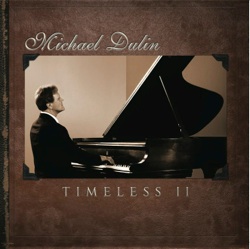Timeless II is the anxiously-awaited follow-up to Michael Dulin’s award-winning 2004 release
Timeless. Dulin has chosen eleven classical pieces and arranged them for a more contemporary audience. Some of the pieces are played as written, while most have added instrumentation to intensify the fundamental meaning of the originals. Dulin is a multi-faceted musician with very deep classical roots who has studied these composers in depth and knows the music intimately. There have been many attempts by various artists to update the classics, but few come from such a knowledgable place as Dulin, and even fewer have his artistic integrity and complete mastery of the piano. Even those who wrinkle their noses at the mention of classical music will find something to love on
Timeless II, and purists who feel that the classics should never be tampered with will appreciate Dulin’s “timeless” arrangements as well as his elegant piano touch.
“Partita” begins the album. Based on the first movement of JS Bach’s B-flat Partita (BWV 825), considered to be among Bach’s most challenging keyboard works, Dulin handles it with ease. Strings were added for color and a silky contrast to the more percussive piano - a great start!
Beethoven’s “Moonlight Sonata” is one of the most popular piano pieces of all time. Dulin plays the piano as written with the addition of strings and a haunting organ part. Perfect in every way, Beethoven must be smiling down from heaven!
“Andante” is Rachmaninoff’s D Major Prelude (Op. 23 #4), written and performed as a piano solo. Reflective and full of longing, Dulin conveys deep emotion as he casts a spell with this stunning piece. Not as flashy as some of Rachmaninoff’s piano music, Dulin demonstrates how evocative “less is more” can be in the right hands.
“Alone” is nothing short of stunning. Based on Chopin’s “Prelude in E minor, Opus 28,” Dulin begins the piece with an introduction (a prelude to the “Prelude”!) that rapidly accelerates up the piano keyboard and then slowly comes back down, hinting at a crisis or emotional tragedy. He then plays the prelude as written, repeating it with strings playing the melody as he adds his own amazing touches and takes the music to an even darker place than Chopin did.
Dulin plays Chopin’s Nocturne in Eb Major (Op. 9, #2) with effortless grace, adding some light string washes.
“Sicilian Song” is an adaptation of “Siciliano” from JS Bach’s
Flute Sonata #2 in Eb Major (BMV 1031). Although Dulin’s arrangement is very true to the piece’s Baroque traditions, adding strings and other orchestration to the piano gives it a more contemporary sound. Played slowly and soulfully, it is absolutely gorgeous!
“Elle et Lui” (literally “She and He”) is Dulin’s arrangement of Chopin’s F Major Nocturne (Op. 15, #1). The “Elle” theme begins and ends the nocturne, and is slow, graceful, and delicate. The second theme (“Lui”) is marked “con fuoco,” which means “with fire.” Changing from F Major to F Minor, it’s dark, stormy, and very fast. Dulin performs both themes to perfection, making the contrasting moods dramatic and colorful.
With chops that are the envy of every pianist I know, Dulin does Chopin proud with his performance of the Etude in E Major (Op. 10 #3). His effortless virtuosity allows each note to sing directly to the heart. Chopin is said to have claimed that this piece is the most personal piece he ever composed, remarking, "In all my life I have never again been able to find such a beautiful melody." Dulin makes it his own.
Saint-Saens’ “The Swan” from his
The Carnival of the Animals is a favorite of pianists and music lovers of all ages. Dulin’s arrangement is mostly solo piano, but includes a gorgeous duet for cello and piano. Arrangements often have the left hand playing elaborate broken chord patterns, but Dulin has simplified the left hand to bring out the melody and to underscore the grace of a swan slowly gliding on a lake.
“Without A Word” is Dulin’s arrangement of Rachmaninoff’s “Vocalise.” The title is especially interesting because although the piece was originally composed for voice (soprano or tenor) and piano, it has no words. It is sung by using any one vowel of the singer’s choosing. Dulin’s solo piano arrangement is faithful to the original, but no, he doesn’t sing! This elegant version is breathtaking!
“Romanza” is the second movement of Chopin’s E Minor Concerto. By definition, a concerto is a piece composed for orchestra and a solo instrument, very often the piano. Dulin performs the orchestrations digitally and the piano to perfection. Slow, melodic, and dreamy, Dulin’s performance reminds me of why Chopin is one of my favorite composers.
It is with good reason that Michael Dulin is known as a pianist’s pianist. There seems to be no limit to what he can do at the piano, yet he makes it all look and sound easy. Fans of Timeless will be thrilled with
Timeless II. Classical music lovers will find this album to be a joy. If you are looking for a top-notch recording that is a little different, check it out! It is available from
michaeldulin.com, Amazon, CD Baby, and iTunes. I give
Timeless II my highest recommendation!

